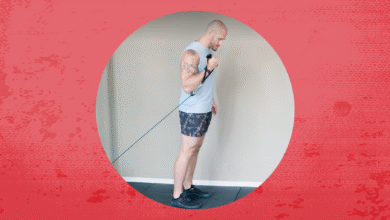Why Am I Already Dealing With Knee Pain in My 30s?

So you spent the weekend getting stuff done—scrubbing the floors, helping a friend move—or clearing your mind with a hike or bike ride. Come Monday morning, what’s your reward? A pair of achy knees.
If you’ve been noticing this more and more, it’s not your imagination: As you pass into your third decade and beyond, changes in your body and lifestyle make your joints more prone to that kind of discomfort. In fact, as you enter the “messy middle” of life, “it’s more uncommon if you don’t have some type of ache in your knees,” Joe Malizia, DPT, CSCS, a physical therapist at HSS Sports Rehabilitation and Performance West Side in New York, tells SELF. That doesn’t mean it’s inevitable, though. A lucky few people do reach their 90s with no evidence of arthritis or other knee problems, orthopedic surgeon Nikkole Haines, MD, assistant professor at Penn State Bone and Joint Institute, tells SELF.
While some of the risk factors for aching joints are genetic, systemic, or otherwise outside your control, there’s still a lot you can do to ward off the types of problems that pop up with age and manage them when they occur. Here’s how to tell the difference between a little age-related stiffness and swelling and something that’s more serious—plus what to do about it.
Here’s why your knees might be aching in the first place.
You’d expect to wake up with some achiness after squatting heavy, hiking a new technical trail, or climbing all 86 flights of the Empire State Building. But when discomfort starts to arise from, well, simple regular activity, that can make you really start to wonder what’s going on.
It all comes down to changes in tissue in and around your knee. This can start decades before osteoarthritis—a condition that occurs when the cartilage inside your joints breaks down over time—which tends to set in around your 50s and 60s.
Muscle mass decreases by about three to eight percent per decade beginning in your 30s, and its quality starts to change too, Dr. Malizia says. “When we’re young, muscle is like a nice filet mignon; it’s supple, it moves really well,” he says—all of which helps support and move your knee joint. But as the years pass, your muscles tend to lose pliability and flexibility, which can translate into extra pressure on the joint, even during everyday activities.
Ligaments and tendons hold your knee joint together, and those also tend to stiffen and tighten with age. That can compress the joint, causing pain or swelling, Dr. Malizia says.
All of these changes are compounded by each person’s asymmetries and unique movement patterns, the effects of which add up over time. For instance, if you always shift your weight to the right when you’re standing, the muscles and ligaments on that side can tighten, pulling your kneecap ever-so-slightly off track in a way that can create irritation underneath. So when you add a little extra activity to a knee that’s already slightly irritated—maybe so slightly you don’t even realize it yet—you wind up with that Monday-morning ache.
Factors like stress and lack of sleep can also contribute by increasing inflammation and scrambling your hormones, which can hamper recovery, Dr. Malizia says. And when life gets busy, your movement habits might not be as consistent as they used to be, potentially exacerbating declines in muscle quality. All that means a single workout or afternoon of hardcore chores could unexpectedly strain your muscles and joints.
What’s more, age-related changes affect other joints as well, including your hips. Sometimes, pain that feels like it’s in your knees actually starts higher up—a wonky hip can throw your knee out of whack, for example. “Every time I’m doing an exam, I’m checking a patient’s hips at the same time as their knees,” Dr. Haines says. “There are a lot of things that overlap.”
Okay, so some aches are just a normal part of aging—but when should I actually worry?
Often, the type of knee pain—which can crop up at the front under your kneecap, along the side, or in the muscles surrounding the joint—that occurs with aging tends to be dull and achy. But the occasional transient sharp pain doesn’t necessarily signal a big problem, Dr. Malizia says.
Tissues in the knee are rich in nerves and blood vessels, which makes them easy to pinch or stress. An awkward step or twist can cause that brief, oh-my-god-I’ve-done-it-now burst of pain, sometimes followed by a sensation of your knee giving way. “That quick jolt essentially turns off your muscles, because your body doesn’t quite know what happened yet,” Dr. Malizia says. Think of it like a system reboot. As long as everything comes back online within a few steps or a few minutes, you should be just fine. (If it lasts hours or longer, leading into the next day, a check-up might be warranted, he says.)
It’s a different story, though, if the sharp pain or instability persists longer or comes after a more serious sudden injury, like a fall, Dr. Haines says. The same goes if you can’t bear weight on your leg or straighten or bend your knee. And while a clicking sensation isn’t a big deal—it might just be your kneecap finding its groove again after a slight pull from your IT band—a “clunking” or grinding feeling is a red flag, Dr. Malizia says. All these point to a more serious problem, such as a torn meniscus or ligament, which need medical treatment.
Swelling, too, can occur on a scale of “no big deal” to “definitely call the doc.” Minor swelling that’s soft and squishy to the touch is probably due to minor irritation or even to something like diet. Alcohol and salty or greasy foods might cause mild inflammation the next day, especially when combined with an activity that’s outside your norm, Dr. Malizia says (say, a night in heels when you’re usually in flats). This type of minor swelling and minimal discomfort, especially if it doesn’t cause you to alter your routine, is likely no big deal even if it lingers for a week or so.
But if you’ve cut way back on your movement and you still have painful swelling after seven to 10 days, seek treatment, he says. And if your knee is so enlarged you can’t spot your kneecap—or if the swelling is firmer, like a foam mattress—you might be looking at more serious damage and should call your doctor.
If my knees are just mildly achy, what can I do to feel better?
For minor knee pain or stiffness, start by resting from activities that caused it or are worsening it, Dr. Haines says. You might need a little longer of a layoff than you think—as much as two to six weeks. “If you’re a runner and you start having knee pain, and you take off a day or two and it gets better but you get right back into it and it comes back—that probably wasn’t enough of a break,” she says.
However, “rest” doesn’t mean “hunker on the couch and do nothing.” Finding a type of movement you can do pain-free maintains muscle strength and mobility in the meantime, so getting back to your routine when the pain subsides won’t be as much of a leap, Dr. Malizia says. Any activity that keeps your pain levels to a minimum—one or two on a scale of 10, where zero is pain-free and 10 is emergency-level agony—can help. Cycling and swimming are particularly good choices because they’re low-impact, but also strengthen your legs and keep your knees moving, Dr. Haines says.
In addition, isometric and other strengthening exercises for your knees and quads can both relieve pain and protect the joint in the future, Dr. Malizia says. He recommends:
- Quad sets. Sit on the floor, put your leg straight out in front of you, and squeeze your quad to flatten your leg into the floor.
- Knee flexion on a step. Put one foot up on a bench or step and rock forward to bend your knee.
- Mini-squats. Lower only as far as you can without making your knees ache worse. Over time, your range of motion should improve.
Most people can also safely use anti-inflammatories such as ibuprofen for minor knee pain, as long as they follow package instructions, Dr. Haines says. But there’s some evidence that taking these drugs can actually delay healing, so you may want to talk with your doctor first, Dr. Malizia says. And try not to use them for more than a few days. If you don’t have any change in your symptoms, you might need a different type of treatment to relieve your pain. Check in with your primary care doc, a sports medicine or orthopedic specialist, or a physical therapist.
So are my knees just going to be this way forever?
Chances are that you will feel more twinges, aches, or discomfort than you did as a kid—but you’re not destined for a life of knee pain. You just may need to keep a few proactive things in mind and be a little more mindful of big jumps in your activity level.
The good news is, the answer isn’t to keep super chill for fear you’ll worsen your “bad knees.” Instead, staying generally active can ward off the muscle loss that occurs as you get older and keep your joints better prepared to handle the extra load from a busy weekend, Dr. Malizia says. Contrary to popular belief, even high-impact exercises like running don’t actually cause arthritis. In fact, the latest research shows running may be protective against knee pain, perhaps by nourishing cartilage so it keeps its cushiness.
That said, when beginning a new fitness program or returning after a break, start where you are and ramp up slowly, Dr. Malizia says. So if you used to run five miles regularly but took a few months off, ease back into it by walking or run-walking rather than heading out for the same old loop at the same pace.
Also, make strengthening the muscles around your knees a priority to prevent pain in the first place. That includes your hamstrings and quads; Dr. Haines recommends half squats, glute bridges, and straight-leg raises (essentially, the flutter kick, with an extra focus on engaging your quads). And don’t forget your hips: “I would say 95% of my knee patients, their hips are weak,” Dr. Malizia says. “Those are muscles that absolutely get neglected in the gym.” Add in a few banded lateral leg raises, multi-task by putting a mini-band around your knees as you squat, or do some clamshells—these moves work the small stabilizing muscles in your side-butt, or your hip abductors.
After your workout, a few stretches or mobility moves—including some time with a foam roller—can keep any budding hip and knee problems from worsening. “Joints in general like to move and they want to move,” Dr. Haines says. “So the more you can preserve your range of motion, the better.”
Finally, stay mindful of your overall sleep and stress levels, Dr. Malizia says. You can’t always control stress, but know that during high-pressure times, your joints and soft tissues are more vulnerable to pain and injury. Take workouts and other activities down a notch and know that you might get a little extra soreness or swelling. In those cases, it isn’t necessarily a red flag of impending doom—think of it more like a check-engine sign, a warning light encouraging you to put a priority on rest and self-care.
Related:



